| “ | As long as I am nothing but a ghost of the civil dead, I can do nothing. | ” |
— Abbott in his first book
| ||
Jack Henry Abbott was an American praised writer and murderer who stabbed to death a Manhattan waiter on July 18, 1981, only six weeks after he had been paroled out of prison thanks to the efforts of author Norman Mailer. After his capture, he was convicted of manslaughter and eventually committed suicide in his cell in 2002.
Background[]
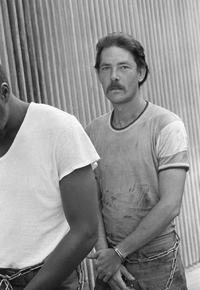
Abbott in chains.
Abbott was born in 1944 in Oscoda, Michigan, to an Irish-American soldier stationed at Camp Skeel and a Chinese woman alleged to be a prostitute. He developed behavioral problems at nine years of age, and never passed sixth grade. His attitude grew even worse after his relocation to several foster homes, ending up incarcerated in two juvenile detention centers before he was twelve. At sixteen, in response to his "failure to adjust to foster homes", he was placed in a long-term reform school, the Utah State Industrial School for Boys. There, he was repeatedly battered and abused by guards, which traumatized him. Abbott remained at the school until his coming of age. He did not wait long before he got into trouble again: in 1963, months after his reinstatement in a society he perceived as hostile, he cashed some checks stolen from a shoe store. He was caught, sentenced to a maximum of five years of imprisonment on a forgery charge, and sent to the Utah State Penitentiary in Draper. There, in 1965, he stabbed to death a fellow inmate. This time he was given three to twenty years for manslaughter. On March 13, 1971, Abbott escaped from prison, fled to Colorado, and robbed a bank in Denver. He was caught after only six weeks, sentenced to nineteen years on a federal charge, and sent to the United States Penitentiary in Marion, Illinois. There, he spent years in solitary confinement for his combative, rebellious behavior.
In the Belly of the Beast and Release[]
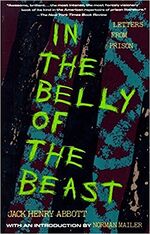
In The Belly of the Beast: Letters from Prison.
At Marion, Abbott began visiting the prison library and reading every book he could get his hands on, particularly the works of philosophers like Russell, Nietzsche, Engels and Hobbes. He also read books by Stalin and Mao, and became a fervent Marxist, blaming "the system" for all that went wrong in his life. In 1977, he contacted famed author Norman Mailer, who was writing a book on double murderer Gary Gilmore (The Executioner's Song), offering his expertise on prison life. Mailer accepted, and, between the spring and summer of 1981, he offered his support to Abbott's release on parole, as well as helped him publish his prison memoirs, In the Belly of the Beast: Letters from Prison, consisting of the huge correspondence between the two. In April, a Utah parole board finally agreed to reintegrate Abbott, also thanks to the efforts of Mailer, who undertook to offer his pupil a job as a secretary once he was out. Despite opposition from prison officials and psychiatrists, Abbott arrived in New York City in June. He was later assigned to live at a Salvation Army halfway house. Not only the ex con was now the hero of New York's literary circles, but soon acquired national celebrity status, appearing in television and being interviewed by Rolling Stones.
Second Murder and Capture[]
On the early morning hours of July 18, 1981 (six weeks after his release), Abbott was having breakfast with two young female socialite acquaintances at the Binibon, a café in Manhattan's East Village, only three blocks from Abbott's halfway house. At some point, he stood up and asked a waiter, 22-year-old aspiring actor Richard Adan, where the restroom was. Adan explained the restroom was for personnel use only, at which point they started arguing in low tones. Then, Abbott told Adan to "take it outside", where the argument continued and ended with Abbott plunging a knife into Adan's chest. After walking away with the terrified girls in tow, Abbott vanished into the night. Adan was later found dead at the scene, and the girls provided the authorities with Abbott's name. Ironically, the very next morning, the New York Times praised In the Belly of the Beast and Norman Mailer's efforts to help Abbott obtain parole.
Absconding and Arrest[]
Abbott was now on the run. He moved to Chicago, through Philadelphia, by bus. There, he attempted to place a call to Mailer, but failed. Then, he moved to Laredo, Texas, where he bribed a Mexican official to let him pass the border. He reached the border with Guatemala, and settled in a small village in the Yucatan peninsula, where he stayed for some days, exhausted and sick from unsanitary conditions. In Vera Cruz, he attempted to board on a ship bound for Cuba, but was unsuccessful. At that point, he decided to simply return to the U.S. through southwestern Texas, where he lived in several flophouses and tent cities while temporarily working at local oil fields. Meanwhile, he forged a Social Security card and adopted the identity of "Jack Eastman". In New Orleans, he briefly worked as a hot dog vendor, local police and the U.S. Marshals always a step behind him. Finally, he was caught in Morgan City, Louisiana, where he was found working inside an oil field. Abbott surrendered without resistance, and remained astonished when he was told his book was now a best seller.
Trials, Imprisonment, and Suicide[]
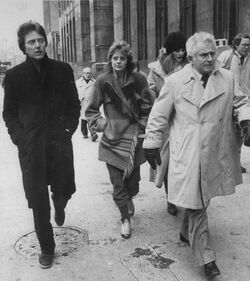
Christopher Walken, Susan Sarandon and Norman Mailer take on a lunch break during Abbott's trial.
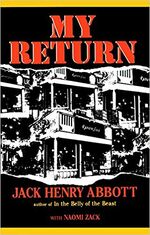
My Return.
Abbott was indicted on October 7, 1981, of second-degree murder. The royalties from his book, as well as any other income deriving from it, were frozen by the court. Meanwhile, Richard Adan's widow, Ricci Adan, filed a $10 million wrongful death suit against him. The trial began on January 3, 1982, in Manhattan Supreme Court. Celebrities of the likes of Christopher Walken and Susan Sarandon (who strongly admired Abbott and named her own son after him) attended the proceedings. Abbott's attorney, Ivan S. Fisher, proposed his theory that the murder was an act of self-defense, while the prosecution argued it was intentional. On the stand, Abbott portrayed himself as a victim of society's wrongdoings and of Adan himself, which the prosecutor counteracted by reading an excerpt from Abbott's book describing a prison knifing in detail, to which he replied: "It's good isn't it?". Finally, on January 22, 1982, the jury acquitted Abbott of the murder charge, and found him guilty of manslaughter. In April, he was sentenced to fifteen years to life, though he first had to finish serving what remained of his federal sentence in Utah. The judge commented the lenient verdict and sentence as follows: "an indictment of a prison system that brutalizes rather than rehabilitates".
Mailer and the literary elite faced wide-spread criticism for their role in Abbott's release. In 1987, Abbott's second book, My Return, was published: it turned out to be a commercial failure. In 1990, Ricci Adan was awarded $7.5 million, plus all the money Abbott made from his book and may have received in the future, by a civil jury. During the civil trial, Abbott claimed Adan "had no future as an actor", and reportedly told Adan's widow her husband's life was "not worth a dime". In March 2000, Abbott was assaulted and left critically injured while in Attica prison. He was transferred to Wende Correctional Facility, in Western New York, shortly thereafter. In June 2001, he appeared before a parole board which denied early release based on his criminal history and lack of remorse for his actions. On February 10, 2002, he was found hanged in his cell with a bed sheet and shoelaces wrapped around his neck. Abbott allegedly left a suicide note, the content of which was never revealed.
Modus Operandi[]
Abbott's murders were both spur-of-the-moment acts committed during a brawl or fight. In each instance, he stabbed his opponent to death with a knife.
Profile[]
Abbott clearly displayed antisocial traits, and was described by psychologist Robert D. Hare as a probable psychopath: he was impulsive, manipulative, totally devoid of empathy, unable to accept disappointments or admit guilt, drank heavily, committed crimes in an almost compulsive way, and believed his actions to be somewhat justified due to his victimization by "the system" (in one instance, he even asked for "an apology of some sort"). He was also a paranoid individual, being convinced that anyone, from the prison guards to society itself, were "out to get him".
Known Victims[]
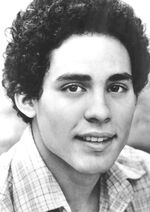
Richard Adan.
- Unspecified date in 1963: Unspecified location in Utah: Stole checks from a shoe store and cashed them
- Unspecified date in 1965: Utah State Penitentiary, Draper: An unnamed fellow inmate (stabbed to death)
- 1971:
- March 13: Utah State Penitentiary, Draper: Escaped from prison
- Unspecified date in Denver, Colorado: A victimless bank robbery
- Unspecified dates at the USP in Marion, Illinois: several prison offences, including drunkenness, assault, and destruction of property
- 1981:
- July 18: 5th Street, Manhattan, New York City, New York: Richard Adan, 22 (stabbed to death)
- Unspecified date in Laredo, Texas: Bribed a Mexican border official
- Unspecified date and location in Texas: Forged a Social Security card
On Criminal Minds[]
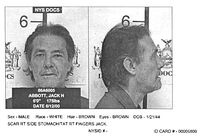
Abbott's prison mugshot, shown in the series' intro.
- Intro: Abbott's prison mugshot was among those shown in the series' intro.
- Season Six
- "25 to Life" - While Abbott was not directly referenced in the episode, he may have provided some sort of inspiration for Donald Sanderson - Both spent most of their respective lives behind bars, were granted parole, and ended up stabbing a man to death shortly after they were released (though, in Sanderson's case, it was really self-defense and it was later found out he had been wrongfully imprisoned from the beginning).
Notes[]
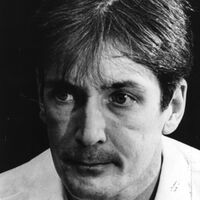
Gary Gilmore.
- As noted by Norman Mailer himself, Abbott shares many similarities with fellow double murderer Gary Gilmore - Both were sociopaths and repeat offenders who committed crimes in Utah and spent the majority of their lives in prison, had a talent of some kind (Abbott was a praised writer, while Gilmore was an accomplished artist), had some sort of relation with Mailer (he helped publish Abbott's memoirs, In the Belly of the Beast, and wrote a book about Gilmore: The Executioner's Song). Also, both murdered people for trivial reasons, and shortly after they were released on parole, generating wide-spread consternation. They even met each other while in prison. Gilmore was executed in January 1977 for his crimes.
